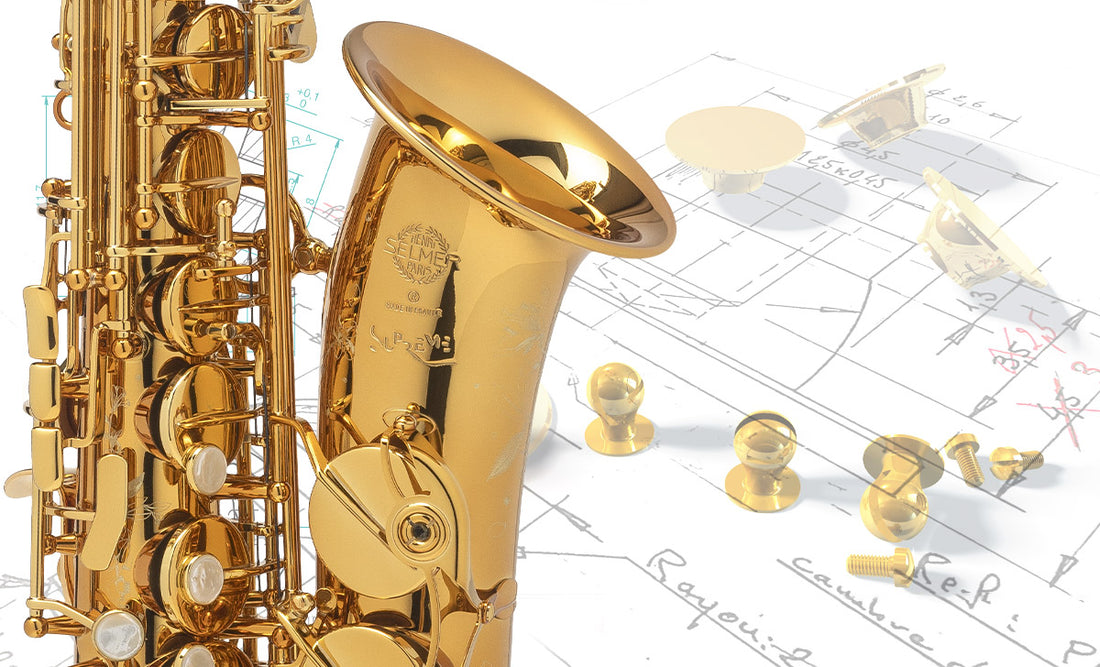Supreme, behind the scenes: the central role of the Research and Development team

How did the development of the Supreme take place?
"The development of the Supreme is of course based on the company's century of experience. This experience is reflected in two ways: firstly, the presence of highly qualified staff with crucial know-how in prototyping and acoustic testing, and secondly, a range of saxophones that are already highly efficient and well-defined, and which serve as the starting point for the project.
In addition, and in an unprecedented way in the history of the company, research work carried out over the last ten years has made it possible to make available new tools to assist in acoustic design. These physical measurement tools have consolidated our knowledge, reducing the number of empirical tests and increasing the efficiency of acoustic tests. They have also made it possible to explore new fields of application in order to push back the limits of the compromise between Tuning, Timbre and Response.

Finally, the integration of musicians from various backgrounds from the outset of the design process, with the aim of offering an instrument that is as universal as possible, brought a richness to the exchanges and the reflection that led to the validation of the prototype."
Who were your main contacts?
"The Research and Development department is obviously at the service of the musicians. They are represented internally by the product manager, but also directly with the musicians from the panel of testers who took part in the testing of the various prototypes, as well as more broadly through the many relationships maintained by the company with the world of music.

Some members of the R&D department are also amateur musicians, passionate about the history of the saxophone and its organology. They take advantage of this dual technical and musical background to create bridges between the expectations of musicians and instrument manufacturing."
What was your biggest challenge?
"The company's ambition was clearly established at the start of the project: to take an acoustic step forward in terms of tuning, flexibility, homogeneity and ease of playing, while retaining the acoustic quality of our current saxophones in terms of timbre. The idea was to propose an innovative instrument with a new aesthetic. We could talk about squaring the circle, with the added objective of creating a universal instrument. Achieving these goals is clearly a big challenge.
Moreover, the transmission of the musicians' emotional expectations to the technical definition of the instrument is also a major psychoacoustic challenge.

The birth of this instrument represents the culmination of many years of passionate work. It has been designed by saxophonists for saxophonists. I hope that it will be welcomed and recognised by our peers for its many qualities and thus perpetuate the long tradition of excellence of Henri SELMER Paris instrument manufacturing."
|
Joël Noury is a traditional assembler in the Research and Development department. He makes saxophone prototypes: manufacturing of sound tubes (brazing of pads, assembly of sub-assemblies, etc.) and assembly/blank adjustment of keys on the tubes. This work is carried out in different cases: it can be various improvements on the existing range, or the development of a new instrument. How is a new instrument designed?"The work starts at a very early stage of the manufacturing process, from a boiler-made instrument on which a whole series of innovations must be adapted until a fully functional instrument is delivered. These improvements are then tested by professional musicians who give their expert opinion to arrive, after many iterations, at a new instrument that will please the panel of musicians. When we start a saxophone prototype, we never know exactly how long this research will last, and it is not unusual for us to have to revise our plans along the way in order to obtain the musicians' validation. It is therefore a long and precise job that requires a lot of attention, patience and know-how. Communication within the department and with the musicians is central to the success of the project." What were the specifics of the Supreme project?"In the Supreme viola project, the musicians come from different musical backgrounds, so it was a real challenge to get their consensus. It is even more difficult because the musicians have increasingly high demands, but that is also what makes my work interesting. I take great satisfaction in having reached the goal of offering the musicians a saxophone with a remarkable sound that fully satisfies their expectations. This saxophone is the result of many years of work for me and my colleagues." |
► Discover the story of the Supreme alto
► Alto Supreme product page